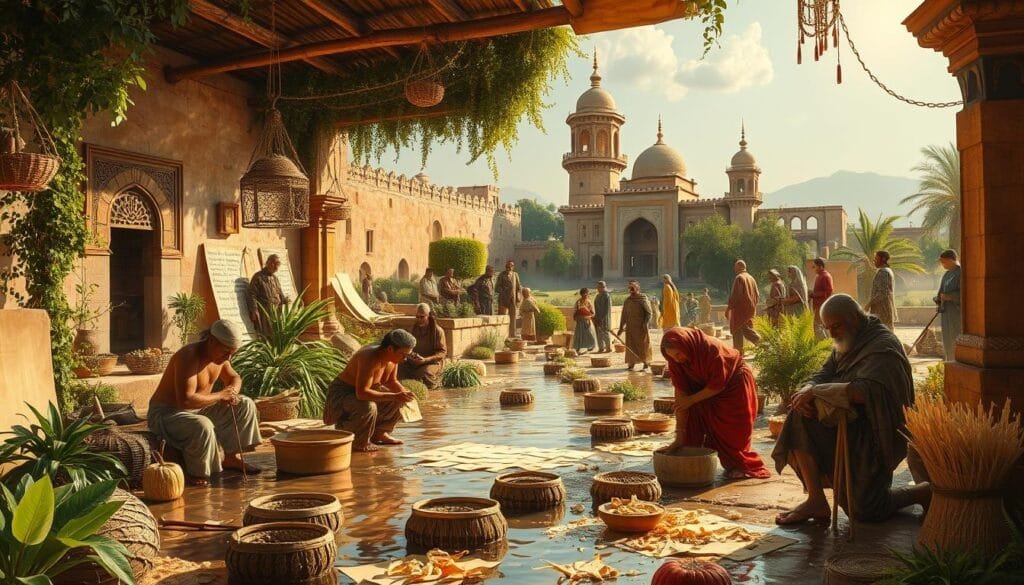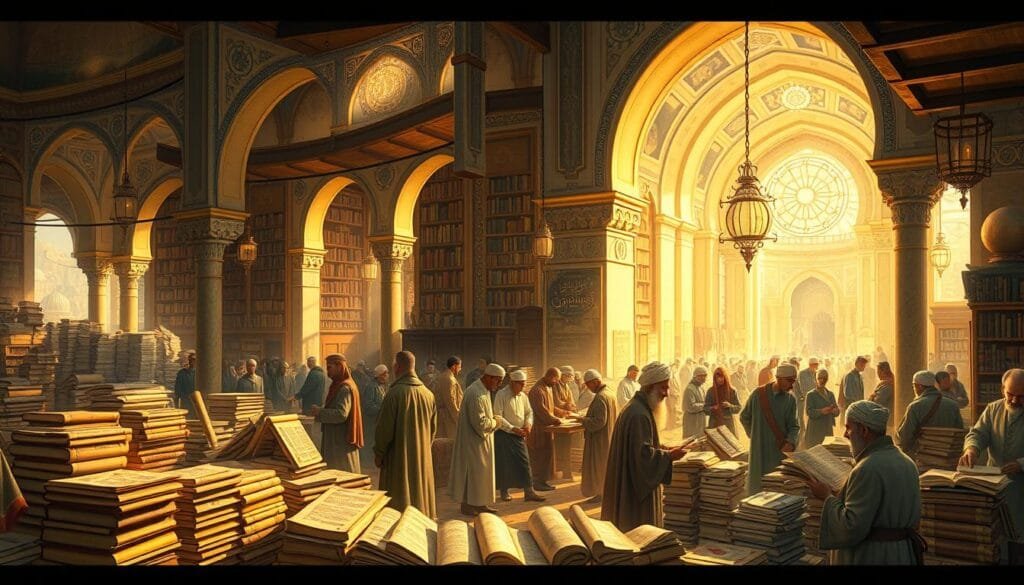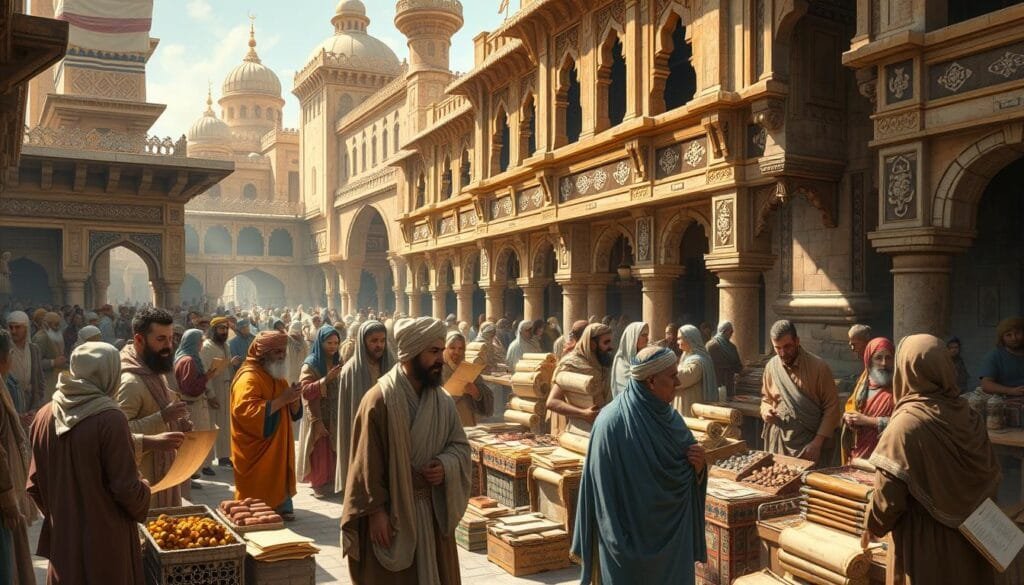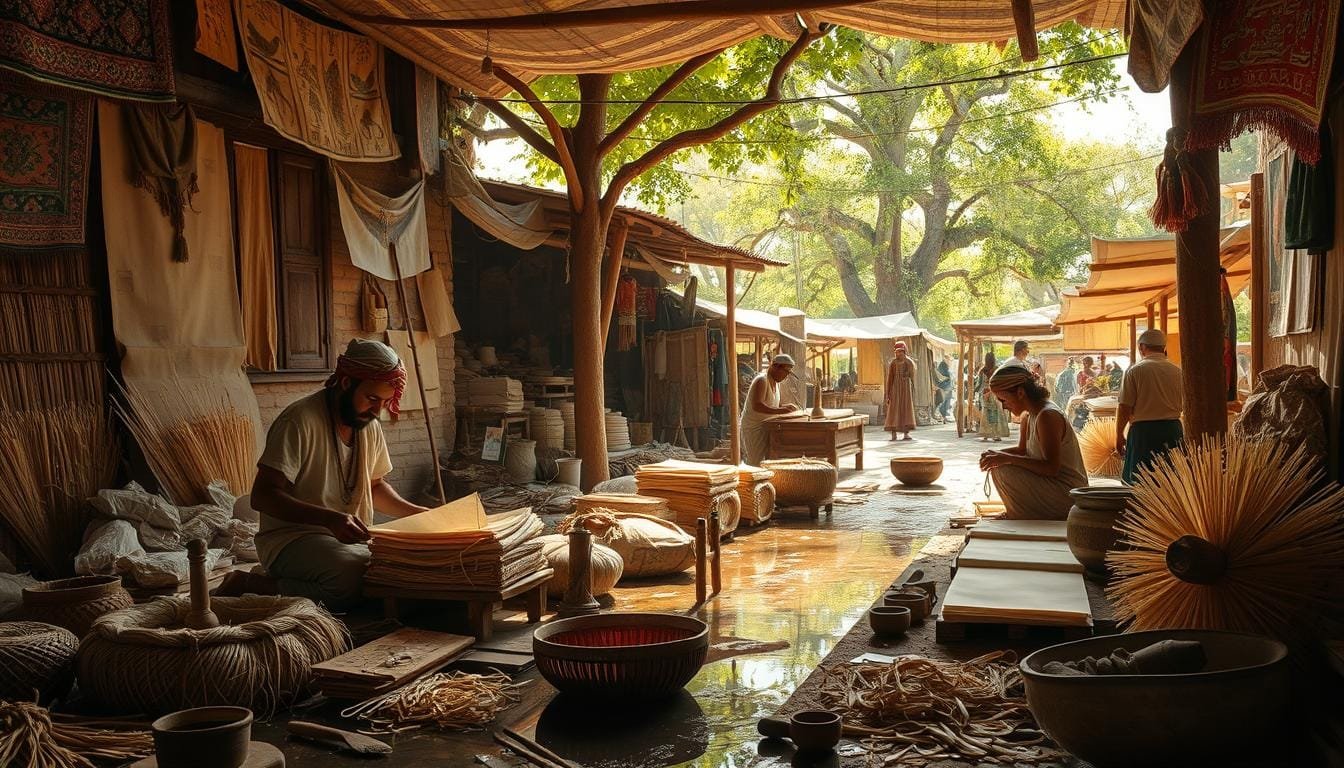Have you ever thought about how a simple invention could change society? When looking at paper production in the Caliphates, we see a major cultural shift. This change began a new age of reading and spreading knowledge. Moving from papyrus and parchment to paper was not just about new technology. It was a huge step in the history of paper. The spread of silk and bamboo paper from China to the Islamic world was significant. It marked an important part of Islamic culture and technology reaching beyond their borders.
Key Takeaways
- The Middle East moved from using papyrus and parchment to paper in the 8th century.
- This shift greatly improved literacy rates and the economy.
- By the late eighth century, Baghdad had a booming paper industry.
- Research shows Islamic societies had higher living standards than European ones in the medieval period.
- Paper use helped improve record-keeping and the spread of knowledge.
- Economic data shows that paper became more accessible despite its changing prices.
Introduction to Paper Production in Caliphates
The story of paper in the Caliphates is a key part of paper history. The shift started with the Battle of Talas in 751 CE. Here, Islamic armies took Chinese paper makers prisoner. This event spread papermaking technology across the Islamic world. It became fundamental to culture and admin work.
The way Caliphates made paper set them apart from China’s methods. Early Chinese paper used plant fibers and old rags. But, Islamic paper makers mainly used beaten rags. This change made paper better and cheaper. It also boosted writing and learning across Islamic lands.
After Talas, papermaking skills quickly went to places like Samarkand, Baghdad, and Spain. This fast spread shows how vital Islamic papermaking was. It changed government, learning, and business life.
In Islamic areas, paper mills were part of a free market. This was different from China’s secret ways. Being open led to more creativity. It built a lasting paper industry. This helped Europe later improve bookmaking and printing.
During the Abbasid era, Baghdad was a hub for culture and science. This period, known as the Islamic Golden Age, lasted from the 8th to 10th centuries. The House of Wisdom in Baghdad drew scholars from all over. They made big leaps in making books. These leaps set standards for later times.
| Event | Impact on Papermaking |
|---|---|
| Battle of Talas (751 CE) | Introduction of Chinese paper craftsmen and technology to the Islamic world |
| Establishment of Baghdad (762 CE) | Creation of cultural and scholarly hub fostering manuscript production |
| Abbasid rule (750-1258 CE) | Increase in paper quality and quantity, spreading to regions like Spain |
| Rise of European papermaking (850-1300 CE) | Influences from Islamic papermaking techniques contributing to European advancements |
| Gutenberg’s printing press (1454-1455 CE) | Heavy reliance on affordable paper stemming from earlier Islamic innovations |
The Origin and Spread of Papermaking
The start of papermaking traces back to China around 105 CE. It was made by Ts’ai Lun who used recycled items like fishing nets and bamboo. This important invention changed many societies around the world.
The Early Diffusion of Papermaking from China
In China, paper became key to spreading knowledge and improving how things were run. By 770 CE, Japan was also making paper, enhancing the technique. They started mass printing texts like the Hyakumanto Dharani. At the same time, regions like Samarkand in Central Asia began making quality paper for sacred texts.

Muslim Encounter with Papermaking in Central Asia
The meeting of Muslims with papermaking in Central Asia was very important. During the 8th century, they saw the value and improved the methods. They were impressed by Samarkand’s strong paper. The first water-powered paper mill appeared in Baghdad in 794 CE, starting a new chapter in papermaking.
The Spread to the Mediterranean and Europe
Papermaking reached the Mediterranean and then Europe. Muslims brought the technology to Spain by the 13th century. From Spain, it spread to places like Italy, France, Germany, and England. This shift in technology helped the Renaissance and increased knowledge sharing.
Impact on Literacy and Knowledge Dissemination
In the 8th century, paper sparked a huge change in medieval Islamic civilization. It led to a burst of creativity in many fields like theology, sciences, and literature. This shift from talking to writing let people save and share huge amounts of knowledge. This greatly improved literacy in Caliphates.
From Oral to Written Culture
Paper became easier to get, which boosted the saving of religious teachings. This was key for sharing knowledge long term. The Quran’s first command, “Iqra’a” [read], shows the value of reading.
The Prophet Muhammad encouraged learning, famously saying to seek knowledge even in far places like China. This shows the value placed on learning various subjects.
Boom in Islamic Libraries
The use of paper made more Islamic libraries pop up. Scholars translated works from Greek to Arabic, creating books. This preserved and shared old knowledge. It also led to new books on topics like cooking and tales like The Thousand and One Nights. These were shared with many more people. It shows how Islamic libraries became key learning hubs.
Standardization of the Arabic Language
Paper helped standardize Arabic, uniting the vast Islamic areas. From the 8th to 15th centuries, Arabic linked scholars from Central Asia to Spain. This improved talking and knowledge sharing. It was a key time for Islamic culture’s growth and output.

Economic Influences on Paper Adoption
The introduction of paper in the Islamic world had a huge economic impact. It made keeping records easier and more efficient, aiding the booming medieval Islamic economy. The switch to paper cut costs compared to parchment and papyrus. It also made trading smoother.
Paper’s wide use boosted the trade economy. Traders kept better records of deals, thanks to paper. The rise of early credit systems and partnerships from the 8th to 12th centuries marked a time of business innovation.
The paper trade and widespread paper use fueled financial progress. The double-entry bookkeeping system began in this era. It was a major improvement for tracking payments and finances clearly. The dinar, a common currency, also helped unify the economy.
Paper also spurred the growth of Islamic banks. The zakat tax on goods like crops supported community equity by aiding the poor. These steps showed how paper improved financial and record systems in the community.
Paper allowed better management of vast trade networks, from the Atlantic to the Indian Ocean and the South China Sea. This led to lower costs and more trade.

| Time Period | Economic Development |
|---|---|
| 9th to 14th centuries | Bank establishments in over eight countries, interest banned in Pakistan, Iran, and Sudan by 2004 |
| 8th to 12th centuries | Introduction of early credit systems and partnerships (mufawada) |
| 14th century onwards | Widespread circulation of the common currency, the dinar |
| Medieval period | Enhancement of the paper trade economy, and adoption of the double-entry bookkeeping system |
| 17th century | Mughal India’s economy accounted for over 25% of the global GDP |
Paper was key to economic success and aligned with the zakat and waqf trusts. These funded vital community services like hospitals. This integration of paper into the economy strengthened the Islamic world, encouraging growth across areas.
How is the Caliphates Producing Paper a Cultural Transfer
The caliphates started making paper, leading to a big cultural change. Before, people used papyrus and parchment. Now, paper became more common, showing a big step in technology and cultural impact.
The Transformation from Papyrus and Parchment
Paper took over from old materials like papyrus. This change happened in the 8th and 9th centuries. It made sharing information easier.
The caliphates learned papermaking from the Chinese. This knowledge helped scholars create works faster. Thus, literature flourished across Islamic lands.
The Role of Government and Commerce
The Abbasid Caliphate really supported scholars. They built places like the House of Wisdom in Baghdad. This helped papermaking and culture spread.
Trade helped too. Their big trade networks made paper more popular. Money from taxes also supported the paper and literature market.
Integration into Everyday Society
Paper quickly became important in caliphate cities like Baghdad. These cities were centers of learning. Paper was everywhere and literacy grew among leaders and officials.
This shift to writing changed administration and record-keeping. It made sure paper was central in Islamic society.
Papermaking changed Islamic societies deeply. It shows how technology, culture, and governance all affect each other.
Raw Materials and Techniques
The arrival of papermaking in the Caliphates changed how materials and techniques were used. This change helped spread knowledge and culture throughout the Islamic world. They adapted and innovated papermaking in many ways.
Sources of Cellulose Fibers
They used cellulose fibers from different plants for papermaking. These plants included flax, hemp, and others. They also recycled textile waste. Having a variety of sources was key for a steady material supply. This variety helped paper become popular and widely made in the area.
Adaptations and Innovations
Islamic papermakers made big strides in improving paper. For example, they used water-driven mills for better fiber processing. They also made molds and sieves better. These steps forward helped meet the high demand for paper and boosted its use in education and administration.
Regional Variations in Techniques
Different spots in the Caliphates made paper in their own ways. For example, Baghdad focused on using local materials. But places near the Mediterranean mixed in techniques from the Byzantine and Europe. This meant papermaking always got new ideas and stayed fresh.
| Region | Primary Materials | Innovations |
|---|---|---|
| Baghdad | Flax, Hemp | Improved Molds & Sieves |
| Central Asia | Sourced Textiles | Enhanced Water Mills |
| Mediterranean | Recycled Textiles | Integration of Byzantine Techniques |
The Role of Religion in Paper Adoption
The impact of religion on papermaking within Islamic Caliphates was huge. The Umayyad Caliphate spread papermaking across various cultures. This greatly changed how people wrote and read.
At first, people hesitated to use paper for the Quran. They preferred using papyrus and parchment, which were traditional. But, as paper became more common, its religious acceptance grew.
Papermaking and the Quran
The Quran on paper was a big deal. Religious leaders saw its benefits. Paper was cheaper and more available.
This change showed openness to new technology. The spread of paper for religious texts was crucial. By the Abbasid era, the Quran was often written on paper. This helped spread Islamic teachings further.
Acceptance by Religious Scholars
Support from religious leaders helped paper become popular. They made sure it fit with Islamic values. This led to a big cultural and intellectual shift.
Paper mills started in cities like Baghdad by the 9th century. Literacy rates in cities soared, reaching up to 70%. Religion played a key role in making paper common. This boosted education and documentation, showing religion’s big impact on papermaking.
For more about religion and politics in Islamic history, read this study.
Long-term Cultural and Social Effects
The history of papermaking in the Islamic world has deep effects. These go beyond just technology and economy. This invention changed culture and society in lasting ways, shaping history itself.
Papermaking truly changed how people learned and shared knowledge. It made paper more available, reducing costs for books and writing. More people could then read and write, boosting literacy and cultural participation.
The Islamic Golden Age witnessed a huge growth in libraries. The House of Wisdom in Baghdad was a key knowledge center. This era saw big advances in science, medicine, philosophy, and arts. It led to a culture where innovation and curiosity flourished.
Paper also helped standardize the Arabic language. Arabic connected people across vast territories. This standardization protected the Quran and other texts, ensuring their accurate sharing over time.
Furthermore, paper improved record-keeping and government tasks in the Islamic empire. Better documentation supported stronger governance and trade. Paper was light and easy to carry, perfect for messages that helped the empire grow.
Various ethnic and religious groups began interacting more because of these changes. In places like al-Andalus, Muslims, Christians, and Jews exchanged cultures. This didn’t always go smoothly, but there was mutual respect and influence.
In the 10th century, Muslims made up about 80% of al-Andalus’s population. This included Christian converts and Berber Muslims. Jews were about 5%. These groups shared ideas and practices, enriching the area’s culture.
The Rashidun Caliphate grew, making Muslim society multi-ethnic. Converts from different backgrounds added to Islamic culture’s richness. This included Persians, Coptic Egyptians, and others.
In the end, papermaking’s legacy is more than technological. It spurred social and cultural growth, making society literate and informed. It helped preserve and share important texts and made administration easier. Today, the influence of papermaking is still seen in our culture.
Conclusion
Paper’s journey in the Caliphates shows deep cultural and tech changes. It started in the 8th century, coming from China. This made a big shift in these areas. By the late 8th century, Baghdad was key for making paper. It took over old materials like papyrus and parchment. This change made writing supplies easier to get. It also started a huge increase in reading and books in Muslim places. This was more than in Christian areas that still used parchment.
Paper making changed the economy too. Making paper was cheaper than making parchment, which needed animal skins. This made libraries grow and the Arabic language became standard. This led to a big time for writing. The fall of papyrus by the 9th century shows how important paper became.
Paper also helped cultures connect across continents. This time is called the Islamic Renaissance. It saved and shared a lot of different knowledge. This helped write down oral stories like the Hadith. Paper made it easier to share knowledge and helped the economy in early Islamic places. Looking at paper’s story during the caliphates shows its big mark on history. It’s a story of innovation, culture, and history all coming together.
FAQ
What is the historical significance of paper production in the Caliphates?
In the Caliphates, paper production was a major change. It allowed them to stop using materials like papyrus and parchment, which didn’t last long and were expensive. This change helped spread knowledge and improve record-keeping.
How did the Caliphates adopt paper production techniques?
The Caliphates learned papermaking from the Chinese. They met in Central Asia. Diverse innovations greatly affected the Islamic world and Europe later on.
What were the early stages of papermaking diffusion?
Papermaking, which started in China, spread thanks to Buddhist monks to Central Asia. There, Muslim Arabs saw its potential and boosted its production. By the eighth century, paper was replacing old writing materials in Baghdad and Europe.
How did paper production affect literacy and learning in the Caliphates?
With paper, more people learned to read and write. Libraries grew, storing a lot of books. This helped with learning and made Arabic easier to standardize.
What economic impacts did the adoption of paper have?
Paper made business smoother. It made transactions and record-keeping easier, cutting costs. This boost in trade helped the Islamic world’s economy grow.
How did the use of paper represent a cultural transfer within the Caliphates?
Shifting to paper was a big deal in technology and culture. The government and people used it in daily life. This showed the impact of the change on everyone.
What raw materials and techniques were used in Islamic papermaking?
To make paper, they used plant fibers or recycled textiles. They created better mills for processing fibers. The paper’s quality and technique varied by region.
What role did religion play in the adoption of paper?
At first, using paper for the Quran was debated. Yet, religious leaders finally approved it. This was a big step for paper in the Caliphates.
What were the long-term cultural and social effects of papermaking in the Caliphates?
Paper led to more people being able to read and write, spreading knowledge. It also helped build a stronger cultural identity. These effects lasted long and reached beyond the Islamic civilization.
